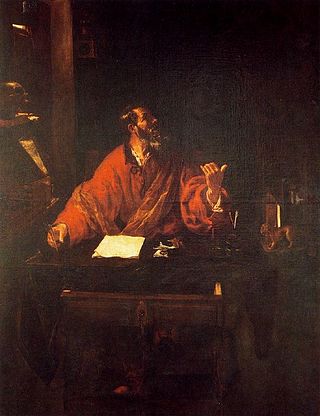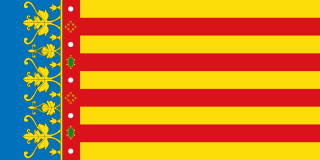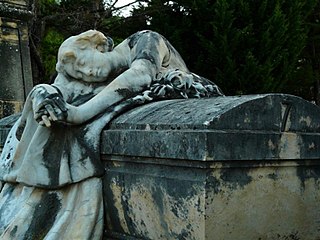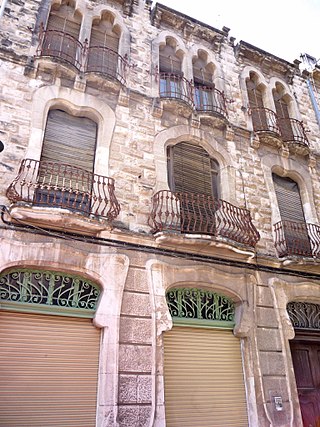
Moros y Cristianos or Moros i Cristians literally in English Moors and Christians, is a set of festival activities which are celebrated in many towns and cities of Spain, mainly in the southern Valencian Community. According to popular tradition, the festivals commemorate the battles, combats and fights between Moors and Christians during the period known as Reconquista. There are also festivals of Moros y Cristianos in Spanish America.

Pedro de Orrente was a Spanish painter of the early Baroque period who became one of the first artists in that part of Spain to paint in a Naturalistic style.

Juan Ribalta was a Spanish painter of the Baroque period. He was born and died in Valencia. His father, Francisco Ribalta, was a famous painter, active in the style of Caravaggio. Some sources said he was born in Madrid and later moved to Valencia. His mother Inés Pelayo died in 1601. Juan's works and style are similar to that of his father. He later painted Saint Sebastian at the Valencia Cathedral in 1616, later the small Adoration of the Shepherds and St. Peter, he also painted portraits including the poet Gaspar de Aguilar.

Friar Nicolás Borrás (1530–1610) was a Spanish Renaissance Catholic monk and painter, active in Valencia.

The Valencian Community is an autonomous community of Spain. It is the fourth most populous Spanish autonomous community after Andalusia, Catalonia and the Community of Madrid with more than five million inhabitants. Its homonymous capital Valencia is the third largest city and metropolitan area in Spain. It is located along the Mediterranean coast on the east side of the Iberian Peninsula. It borders Catalonia to the north, Aragon and Castilla–La Mancha to the west, and Murcia to the south, and the Balearic Islands are to its east. The Valencian Community is divided into three provinces: Castellón, Valencia and Alicante.

Alcoy is an industrial and university city, region and municipality located in the Valencian Community, Spain. The Serpis river crosses the municipal boundary of Alcoy. The local authority reported a population of 61,135 residents in 2018.
Roberto López Corrales, also known by the artistic pseudonym ROLOCO, is a Spanish visual artist and composer.

Valencian Gothic is an architectural style. It occurred under the Kingdom of Valencia between the 13th and 15th centuries, which places it at the end of the European Gothic period and at the beginning of the Renaissance. The term "Valencian Gothic" is confined to the Kingdom of Valencia and its area of influence, which has its own characteristics.

The Llonja de Sant Jordi is a room of exhibitions of Alcoy (Alicante), Valencian Community, located under the floor of the Plaça d'Espanya.
Timoteo Briet Montaud was a Spanish architect, one of the main architects of the Art Nouveau in Alcoy and the Valencian Art Nouveau.

Vicente Juan Pascual Pastor was a spanish architect, one of the main architects of the Art Nouveau in Alcoy and the Valencian Art Nouveau.

Art Nouveau in Alcoy, as one of the main focuses of the Valencian Art Nouveau, is the historiographic denomination given to an art and literature movement associated with the Art Nouveau in Alcoy (Alicante), Valencian Community, in Spain.

Valencian Art Nouveau is the historiographic denomination given to an art and literature movement associated with the Art Nouveau in the Valencian Community, in Spain.

The Casa del Pavo is a private building at 15 Sant Nicolau Street, in the city center of Alcoy (Alicante), Valencian Community, Spain. It is one of the main works of the Art Nouveau in Alcoy.

The Casa Laporta(Laporta house) is a private building at 26 País Valencià avenue, in the city center of Alcoy (Alicante), Valencian Community, Spain. It is one of the main works of the Art Nouveau in Alcoy.

The Casa d'Escaló(Escaló house) is a public building at 2 Joan Cantó street, in the city center of Alcoy (Alicante), Valencian Community, Spain. It is one of the main works of the Art Nouveau in Alcoy.

The Cementerio de San Antonio Abad(transl. Saint Anthony Cemetery) or Cementeri d'Alcoi is a cemetery located in Alcoy (Alicante), Spain.

The Casa Vilaplana(Vilaplana house) is a private building at 8 Joan Cantó street in the city center of Alcoy (Alicante), Valencian Community, Spain.

The Casa Briet is a private building at 24 Sant Josep Street, in the city center of Alcoy (Alicante), Valencian Community, Spain.
Art Nouveau in Madrid is the historiographic term given to the artistic style Art Nouveau as it developed in and around Madrid, the capital of Spain, around 1900, permeating architecture, design, the decorative arts, graphic arts, and broader culture. There is also a “Modernismo madrileño” in the field of literature, likewise situated in the capital and considered to be the nucleus of the origins of the modern movement of Spanish literature.
















